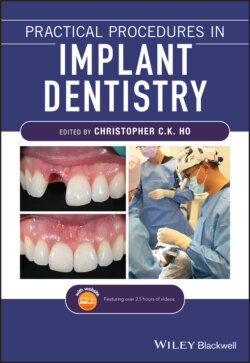Читать книгу Practical Procedures in Implant Dentistry - Группа авторов - Страница 60
7.2.1 Importance in Oral Implantology
ОглавлениеWhile the incisive foramen and canal are seldom selected as a site for placement of a dental implant these anatomical features can limit the bone volume available for implant placement in the anterior maxilla, specifically the central incisors. This can be a common occurrence in patients with a resorbed maxillary alveolar process secondary to tooth loss. In these individuals the distance in the sagittal plane between the anterior border of the incisive foramen and canal and the buccal plate of the anterior maxilla is often reduced in comparison with subjects that are dentate in this region. The incisive foramen and canal are positioned proximal to the confluence of the nasal septum, nasal floor, anterior nasal spine, and hard palate when viewed from the frontal plane. The complex bony architecture in this region limits the effectiveness of pre‐operative evaluation using traditional two‐dimensional periapical radiographs. Three‐dimensional imaging via cone beam computed tomography (CBCT) scans provide more accurate assessment of both foramen and canal morphology, which can vary significantly [3], and allow for evaluation of available bone volume.
At times, the location and morphology of the incisive foramen and canal may prevent placement of dental implants in the position of the maxillary central incisors, as seen in the clinical case highlighted in Figure 7.1. If the proposed treatment does not permit the selection of alternative suitable sites for dental implant placement guided bone regeneration (GBR) techniques may be required to augment the bone volume anterior to the border of the canal to facilitate implant placement in that area. The incisive canal itself can be grafted in a procedure called incisive canal deflation to provide further bone volume for subsequent implant placement. This technique can be performed under local anaesthetic with reflection of a full‐thickness flap raised, permitting access for complete removal of canal contents via rotary curettage. The canal can then be grafted with particulate bone without long‐term ill‐effects to the patient [4, 5]. While a transient loss of sensation in the anterior maxillary palatal area is possible, the revascularisation and reinnervation of the region due to the anastomoses with the greater palatine artery and nerve typically return sensation within several months.
Figure 7.1 Three‐dimensional versus two‐dimensional view of incisive foramen. A CBCT scan can provide invaluable information about the true anatomical relationship between the incisive foramen and the proposed site for a dental implant. The 3D reconstruction from the CBCT scan depicted in (a) and (b) allows for a more accurate assessment of the edentulous site when compared to the 2D periapical radiograph (c). The sagittal slice (d) shows the enlarged foramen.
